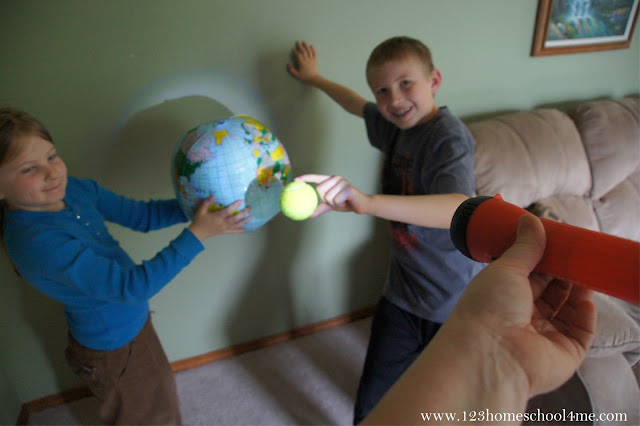For the first week of our Solar System Unit we learned that the solar system is the sun and all the planets that travel around the sun which is held in place by gravity. Gravity is an invisible force that pulls objects towards each other.
What is Astronomy?
We learned that astronomy is the study of the universe.
We read through our solar system unit vocabulary cards from these free solar system worksheets such as: universe, constellations, gravity, astronomer, and more.
We learned about Copernicus who fist proposed that the earth actually revolved around the sun instead of the idea that everything revolved around the earth as was thought at the time. We also talked about Galileo who was an astronomer that taught us to use a telescope to study the planets and stars.
Planets
The kids were introduced the the sun, 8 planets (Mercury, Venus, Earth, Mars, Jupiter, Saturn, Uranus, and Neptune), over 100 moons in our solar system, the asteroid belt, and Pluto with these hands on solar system activities for kids.
First we made this fun, easy to make Yarn Solar System Project.
We reinforced where the planets were with these solar system coloring pages and planets mini book.
Then we headed outside to recreate the solar system with chalk on our driveway. We played a game where the kids had to run to the correct planet when I called it out.
I helped the kids understands how our planets orbit the sun by having them do this fun activity that helped them really “get it”.
The Sun
We started about by learning that the sun is a star, the biggest thing in our universe, and very hot - 10,000 degrees on the outside and millions of degrees on the inside. We learned about solar flares, sun spots, and that the sun is actually all the colors of the rainbow! We learned that the sky looks blue because it has a shorter wave that gets hits the layer of gases in our atmosphere.
To help kids understand the power of the sun and the importance of not staring at the sun we did this simple, classic experiment where the kids used a magnifying glass to direct the sun's ray to burn a hole in a leaf.
Note: This should only be done carefully with adult supervision. I recommend you take the opportunity to talk about safety.
We learned that we can tell time and seasons using our solar system. We took a peak at Stonehenge that many people believe was used to tell when spring had arrived - useful for helping them know when to plant and harvest crops.
The sun heats things up! We made a solar oven to harness the energy from the sun. We used plastic wrap to create a greenhouse, used aluminum foil to reflect the rays, black tape to hold in the heat, and waded up paper to insulate the bottom. We got our solar oven up to 320 F.
This fun-to-make Lego Sundial was a fun way for kids to see how we can tell the time based on the position of the sun. Then the next day we used the sundial to tell the time instead of a conventional clock. Science is FUN!
For another fun idea, try our human sundial for a truly memorable science project.
We learned that a solar eclipse happens when the sun gets hidden behind the moon and for a few moments during the day you can't see the sun. Sometimes there are up to five in one year; but they can't be seen from everywhere on earth.
To help kids understand the concept we used a inflatable earth, tennis ball, and a flashlight to recreate a solar eclipse.
More Science Activities for Kids
- Biology Vocabulary Flashcards (work with any curriculum) K-6th
- Hatching Baby Chicken Notebook K-6th
- Crystals - How to Grow Crystals K-6th
- Dinosaur Unit K-6th
- Earth Science Unit K-6th
- Habitat Adventure Game (Exploring Biomes, Animals, and Taxonomy) K-6th
- Hatching ButterfliesK-6th
- How to Make a Lava Lamp - K-6th
- Zoo Scavenger Hunts - 17 different hunts for kids Toddler - 6th Grade




















